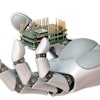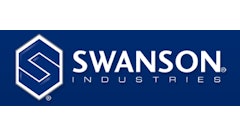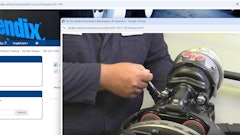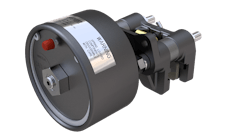Back in 1970, the original Federal Motor Vehicle Safety Standard (FMVSS) 121 proposal would have required buses, single unit trucks, and empty truck-tractors to meet the same 216 ft., 60 mph stopping distance mandated for light-duty vehicles. It became apparent this was beyond the technology available then, so these vehicles were permitted a much longer stopping distance, up to 335 ft. for truck-tractors, which has been the standard for the last 36 years.
A lot has changed in that time, though, with developments like disc brakes, electronic braking systems (EBS), and high-performance "S-cam" units replacing much of the technology current in the 1970s. As a result, the National Highway Traffic Safety Administration (NHTSA) has re-visited the issue, and proposed a new standard that will apply the 216 ft. distance requirement to virtually all vehicles.
NHTSA says that most brake manufacturers support the new standard, but the issue does not end there because the loads generated in stopping a vehicle up to 30% faster impact much more than just the brakes. That fact presents heavy-duty OEMs and component suppliers with a major challenge because wheels, tires, suspension, and other chassis components are all involved as well as the brakes. Regardless of how well the brakes perform, meeting the new standards still will require extensive testing and development both in the laboratory and on the road.
Technology to the rescue
Measuring the various loads placed on a truck wheel while it's actually in operation is a daunting task, considering that the wheels are in motion and subject to the impact of weather, curbs, potholes, rough pavement, and the occasional rock. Daunting, yes, but far from impossible.
A solution developed by RS Technologies of Farmington Hills, MI, is a line of road load wheel sensors specifically designed for heavy-duty truck applications. These wheel force transducers (WFTs) can be used on cab wheels, single or tandem trailer wheels, and even the new generation of "super single" wheels that are now migrating here from Europe.
"A WFT can measure longitudinal, lateral, and vertical forces plus turnover moment, wheel torque, and turning moment," explains RS Technologies president Ralph Shoberg. "Our new WFTs have a superior temperature compensation capability that makes them useful even for maximum force braking tests.
"But, while wheel torque sensors are of importance in brake testing, they provide only part of the information essential to heavy truck braking studies. Six-component WFTs measure horizontal braking force as well as the vertical loading on each wheel in addition to the braking torques. Due to the significant inertia, the so-called "flywheel effect", of heavy truck wheels, it is essential to measure the braking force in addition to the braking torque on each wheel to fully characterize the vehicle's dynamic behavior. Measurement of the vertical load on each wheel provides essential information on weight transfer during dynamic braking tests.
"So as you can see," Shoberg continues, "the complete set of measurements available with a WFT provides important insights into overall system performance, and that's a critical benefit. Moreover, our WFT sensors are sensitive enough to be used for tire performance tests such as rolling resistance drag determinations, yet tough enough to withstand the most severe braking forces."
RS Technologies' WFTs are based on a durable, one-piece flexure machined from either aluminum or titanium depending on the load being measured. Aluminum flexures are intended for loads up to 140 kN (31,500 lbs.) and torques up to 30 kNm (265,000 lb-in.). Titanium flexures are rated at 220 kN (49,000 lbs.) and 50 kNm (442,000 lb-in.).
Both types of flexure are available in a range of sizes to fit virtually all truck wheels, including those for "super single" tires. The flexure, which contains the strain gages, signal processing, and data communications components, is mounted in various ways depending on the application.
For single cab wheels and "super single" wheels, it's mounted on the hub, which then accepts a modified standard rim. For dual wheels it's mounted on the axle between the rims.
The flexures are easily mounted and offer a choice of slip ring or telemetry data links. All of the WFT components are designed to withstand on-road impact and vibration loads, along with splash and even short-term submersion for telemetry-equipped units.
A fully-integrated solution
"The WFT system gives the heavy truck industry a standardized, fully-integrated computer aided data acquisition (CADA) system for wheel system engineering that can be configured to meet virtually any requirement they may have," Shoberg says. "The system is easy to install and easy to interface with our signal processing and data analysis systems, and those made by other manufacturers."
RS Technologies uses a transducer interface unit (TIU) produced by its joint venture partner, CAESAR DataSystems of Munich, Germany. The TIU is fully integrated into the WFT's data acquisition system. The 96-channel TIU handles all force, torque, and position communication between up to four WFTs and the data acquisition system. It is configured to fit a standard 5-inch rack mount, and is available in either 8.5-inch or 19-inch widths.
"Because the whole package is integrated, set-up and calibration are exceptionally quick and easy," Shoberg says. "After a 10-minute warm-up, and a 3 to 5 minute non-running adjustment the system is ready to go." Calibration information can be stored on a microchip in each WFT so that it can be uploaded very quickly to the CAESAR DataSystems modular data acquisition (MOPS) system.
MOPS collects data from analog and digital sensors as well as from serial interfaces or PCM data coming from a telemetry link or DAT (Digital Audio Tape) recorder and passes it in synchronized form to the computer. The MOPS unit itself is very compact but still provides signal conditioning for up to four WFTs plus onboard calculation capabilities.
It's also expandable with additional signal conditioning capabilities for strain gages, pressure sensors, accelerometers, LVDTs, RPM sensors, and other digital signals or data busses, including CAN. The MOPS unit can be directly interfaced to onboard PCs, or analog outputs can be provided for external DAQ.
"Data acquisition software is the heart of the system," Shoberg says. "Our system provides for on-line calibration and supervision of wheel sensor status and records any potential errors such as excess angle deviations, shunt cal value mismatches, and large zero offsets along with the data stream.
"All settings are recorded in a protocol trace file which can be displayed later as corner loads, zero offsets, or shunt cal values. The software also provides on-line recording of resolved signals and gives engineers the opportunity to store all signals, or selected sub-sets such as resolved signals only, for example. This can greatly simplify analysis by presenting only relevant data."
Like the systems it will be used to test and perfect, the heavy truck version of the RS Technologies WFT was not available in 1970. But it is today, and that fact will significantly simplify the task of engineering the systems required to meet the next generation of FMVSS 121 standards, and probably the generation after that, as well.
![Sa P75 I Sahr[80]](https://img.oemoffhighway.com/mindful/acbm/workspaces/default/uploads/2025/10/sa-p75-isahr80.Cn3n79HB4H.jpg?auto=format%2Ccompress&fit=crop&h=100&q=70&w=100)



![Sa P75 I Sahr[80]](https://img.oemoffhighway.com/mindful/acbm/workspaces/default/uploads/2025/10/sa-p75-isahr80.Cn3n79HB4H.jpg?ar=16%3A9&auto=format%2Ccompress&fit=crop&h=135&q=70&w=240)










